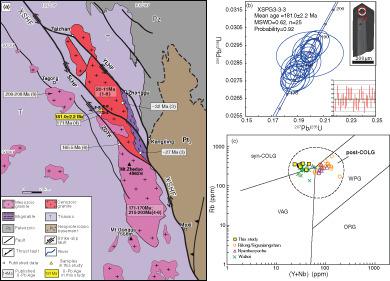当前位置:
X-MOL 学术
›
Geolog. J.
›
论文详情
Our official English website, www.x-mol.net, welcomes your
feedback! (Note: you will need to create a separate account there.)
Jurassic post‐collisional extension in the Songpan–Ganze Terrane, eastern Tibetan Plateau: Evidence from weakly peraluminous A‐type granites within the Zheduo–Gongga Massif
Geological Journal ( IF 1.4 ) Pub Date : 2020-11-09 , DOI: 10.1002/gj.4034 Chan Wu 1 , Shaocheng Ji 2 , Hui Cao 3 , Hanwen Dong 3 , Xijie Chen 4
Geological Journal ( IF 1.4 ) Pub Date : 2020-11-09 , DOI: 10.1002/gj.4034 Chan Wu 1 , Shaocheng Ji 2 , Hui Cao 3 , Hanwen Dong 3 , Xijie Chen 4
Affiliation

|
The Mesozoic–Cenozoic Zheduo–Gongga Massif, eastern Songpan–Ganze Terrane, can provide important clues for the crustal evolution in response to syn‐ and post‐orogeny. Here, we document petrological and geochemical characteristics of Early Jurassic granites (181.0 ± 2.2 Ma) within the massif along the Xianshuihe Fault in the eastern Tibetan Plateau. The granites have high contents of SiO2, Na2O + K2O, FeOT/MgO, 10,000 × Ga/Al, REE (except Eu) and HFSE (e.g., Nb, Ta, Zr, Hf), low CaO, TiO2, P2O5 and negative Eu, Sr, and Ba anomalies. Zircon REE shows a similar pattern with the whole‐rock REE. Our new data demonstrate weakly peraluminous A‐type affinity with A/CNK >1.0 and alkali‐calcic, ferroan features. Zircon saturation temperatures and geochemical features (e.g., high SiO2 and low MgO contents, high Rb/Ba and Rb/Sr ratios) indicate that the granites resulted from high‐temperature (>800°C) partial melting of Triassic flysch rocks in relatively shallow crust (<500 MPa or <20 km). Zircon εHf(t) values range from 0.55 to 2.91 and the corresponding two‐stage TDMC are older than the neighbouring Kangding complex and Yangtze margin, implying possible contribution of mantle materials to the parent magma. Considering the tectonic events and the regional geology, the magma was generated in a post‐collisional setting, which was possibly driven by the upwelling of hot mid–lower crustal materials due to the break‐off of subducted Palaeo‐Tethys Ocean slab. Under this situation, the magma may move upwardly into the pre‐existing Xianshuihe Fault during the post‐collisional extension of the thickened crust. Thus, slab break‐off played a key role in the genesis of the Zheduo–Gongga Massif studied herein.
中文翻译:

青藏高原东部松潘—甘孜地带的侏罗纪碰撞后伸展:浙多—贡嘎地块中弱铝质A型花岗岩的证据
松潘—甘孜地带东部的中生代—新生代—贡嘎地块,可以为响应同生代和后造山带的地壳演化提供重要线索。在这里,我们记录了青藏高原东部鲜水河断裂带沿地块内侏罗纪早期花岗岩(181.0±2.2 Ma)的岩石学和地球化学特征。花岗岩中的SiO 2,Na 2 O + K 2 O,FeO T / MgO,10,000×Ga / Al,REE(Eu除外)和HFSE(例如Nb,Ta,Zr,Hf),高CaO, TiO 2,P 2 O 5负Eu,Sr和Ba异常。锆石稀土元素与整个岩石稀土元素表现出相似的模式。我们的新数据表明,A / CNK> 1.0且具有钙,铁,铁的特征,具有弱的铝质A型亲和力。锆石的饱和温度和地球化学特征(例如,较高的SiO 2和较低的MgO含量,较高的Rb / Ba和Rb / Sr比)表明,花岗岩是三叠系复石岩高温(> 800°C)部分融化的结果浅层地壳(<500 MPa或<20 km)。锆石εHf(t)值的范围从0.55到2.91,以及相应的两级T DM C比邻近的康定情结和长江边缘早,表明地幔物质可能对母岩浆有贡献。考虑到构造事件和区域地质,该岩浆是在碰撞后的环境中产生的,这可能是由于俯冲古特提斯洋板块破裂而引起的中低层地壳热上升所驱动的。在这种情况下,在加厚地壳的碰撞后伸展过程中,岩浆可能会向上移动到已存在的鲜水河断层中。因此,平板断裂在本文研究的Zheduo-Gongga地块的成因中起着关键作用。
更新日期:2020-11-09
中文翻译:

青藏高原东部松潘—甘孜地带的侏罗纪碰撞后伸展:浙多—贡嘎地块中弱铝质A型花岗岩的证据
松潘—甘孜地带东部的中生代—新生代—贡嘎地块,可以为响应同生代和后造山带的地壳演化提供重要线索。在这里,我们记录了青藏高原东部鲜水河断裂带沿地块内侏罗纪早期花岗岩(181.0±2.2 Ma)的岩石学和地球化学特征。花岗岩中的SiO 2,Na 2 O + K 2 O,FeO T / MgO,10,000×Ga / Al,REE(Eu除外)和HFSE(例如Nb,Ta,Zr,Hf),高CaO, TiO 2,P 2 O 5负Eu,Sr和Ba异常。锆石稀土元素与整个岩石稀土元素表现出相似的模式。我们的新数据表明,A / CNK> 1.0且具有钙,铁,铁的特征,具有弱的铝质A型亲和力。锆石的饱和温度和地球化学特征(例如,较高的SiO 2和较低的MgO含量,较高的Rb / Ba和Rb / Sr比)表明,花岗岩是三叠系复石岩高温(> 800°C)部分融化的结果浅层地壳(<500 MPa或<20 km)。锆石εHf(t)值的范围从0.55到2.91,以及相应的两级T DM C比邻近的康定情结和长江边缘早,表明地幔物质可能对母岩浆有贡献。考虑到构造事件和区域地质,该岩浆是在碰撞后的环境中产生的,这可能是由于俯冲古特提斯洋板块破裂而引起的中低层地壳热上升所驱动的。在这种情况下,在加厚地壳的碰撞后伸展过程中,岩浆可能会向上移动到已存在的鲜水河断层中。因此,平板断裂在本文研究的Zheduo-Gongga地块的成因中起着关键作用。











































 京公网安备 11010802027423号
京公网安备 11010802027423号